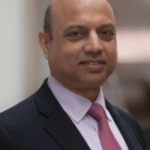
(EDITOR’S NOTE: This article wraps up Markets Media’s coverage of the WBR Fixed Income Leaders Summit. You can find previous coverage from the event here.)
How can institutional fixed income traders leverage the latest technologies to do their jobs better?
That was a focal question at the WBR Fixed Income Leaders Summit, which took place in Boston June 6-8.
To be sure, doing more with less is a perennial topic at industry events, including the five-year-old #FILS. But speakers and attendees noted things are decidedly further along the curve this year, and artificial intelligence has trading desks poised for more marked gains.

Jim Switzer, AB
“There is definitely a greater sense of urgency from past conferences, with regard to innovation, efficiency, and automation,” Jim Switzer, Head of Credit Trading at AllianceBernstein, told Markets Media after the event. “People are thinking about how they trade — should it be different from the way they used to trade?”
In a fragmented landscape with an array of options for liquidity sourcing, a first step is having the right pipes in place. “There is a lot of talk about electronic execution, but I think the market is starting to step back and say let’s not get ahead of ourselves with electronic execution — let’s focus on electronic connectivity,” Switzer said. “When we solve for connectivity and we solve for efficiency, that will lead us to greater liquidity.”
Data augmentation, interoperability of systems, and the rise of passive investing and exchange-traded funds were other event themes cited by Switzer. “Has the ETF ecosystem affected the way we think about trading bonds and transferring risk?” is an ongoing question for the buy side.
Jim Switzer @AB_insights, Gregg Moore @Schroders, Chris Dopp @DeutscheBoerse, Rick Shiffman @MarketAxess, Steve DiVittorio @Barings and Capital Advisors Group’s Anthony Cucinotta discuss navigating liquidity fragmentation with moderator, Chris White @viablemkts. #FILS pic.twitter.com/RBVj3RCmYU
— ViableMkts (@viablemkts) June 7, 2018
“The summit highlighted the increasing use of technology by fixed income market participants in accomplishing best execution, sourcing liquidity, real-time compliance and risk management, said Sam Priyadarshi, Head of Portfolio Risk and Derivatives at Vanguard. “Several conference participants spoke about the use of automation, artificial intelligence, machine learning, and natural language processing for data analytics, generating alpha, and workflow efficiency gains.”

Sam Priyadarshi, Vanguard
Automation Demarcation
Speakers noted that trade automation has evolved from largely a curiosity a decade ago, to a necessity for today’s institutional desks. But there is a border that divides when automation is indicated and when it’s not; if a trade is of a certain size and/or complexity, a human touch is necessary.
Top optimize efficiency, trading desks need to automate up to the dividing line — which itself is gradually moving higher as the market’s technological capabilities evolve.
Mike Nappi, Senior Diversified Fixed Income Trader and Manager of Business Systems Analysis at Eaton Vance, spoke on a June 7 panel about automated execution. He noted that some trading-platform operators and technology vendors have rolled out automated-trading functionality in recent years, applicable to request for quote (RFQ) transactions.
“Basically you put in a group of parameters, and if all those parameters are met, the trade automatically happens,” Nappi told Markets Media before the conference. “If you think about what a trader is doing, a lot of times they’re just asking the same questions over and over. So if you figure every trade takes a trader 30 to 60 seconds to make a decision, you can save quite a bit of time.”
“How can we get the machines to do more?” is an overarching question for trading desks, Nappi noted.
Straight through processing of most trade orders reduces operational risk; data aggregation and price discovery are other ways desks can reduce trader workload. That’s according to Alex Sedgwick, Head of Fixed Income Market Structure at T. Rowe Price.
Bill Adams of MFS says he’s using data science to analyze the MFS research process and looking for idiosyncrasies in style that might represent unconscious style bias. Very interesting ideas. #FILS
— Ken Monahan (@Foudroyant) June 8, 2018
“Reducing the search cost for liquidity is also key – this can be accomplished by better connections to a larger network of trading platforms,” Sedgwick said before the conference in an e-mailed response to questions. “(Regarding) automation of the trading workflow — how are different houses managing their workflow, and combining humans with machines to improve workflow efficiency?”
Sedgwick cited latent liquidity, which he defines as trade orders that never make it from the portfolio manager to the trading desk, either because of price uncertainty or skepticism about liquidity.
“There is a greater push for sources of data that can address these issues and an increasing interest in sharing data with participants in the investment process that don’t sit on the desk,” Sedgwick said. “This is, in many ways, an continuation of the evolution of the trader as a liquidity consultant.”
It was neck and neck for a while but technology pulled ahead late for the win. #FILS pic.twitter.com/oiKKA23G6f
— Markets Media (@marketsmedia) June 8, 2018
AB’s Switzer could sum up the takeaway of the three-day Boston event in one word: systematize.
“In years past people would come to these conferences and it would be about using different platforms and things like that,” Switzer said. “But now, there’s a greater sense around the margin pressures faced by the industry, so we have to rethink how we do things.”
“Systematizing our process is really important. Systematizing our quant views, our fundamental views, and our liquidity views. Systematizing our order building and our investment process,” Switzer said. “All of it makes us faster and more efficient.”





